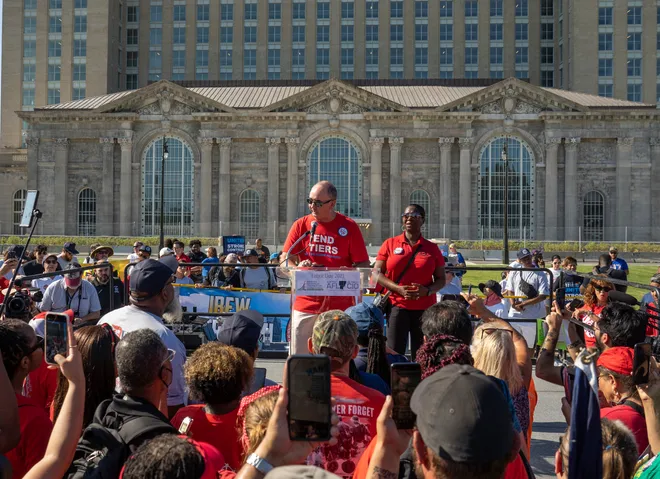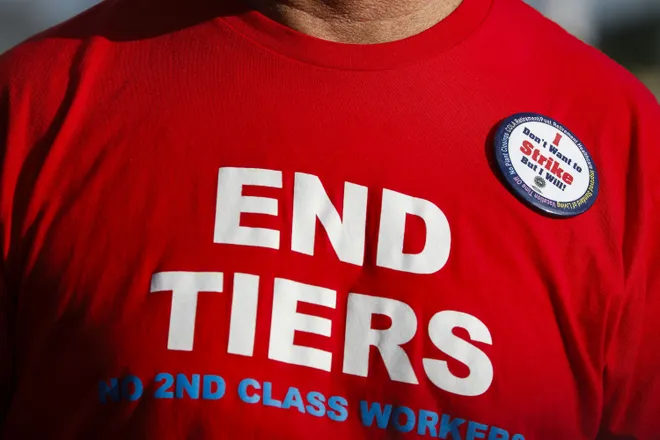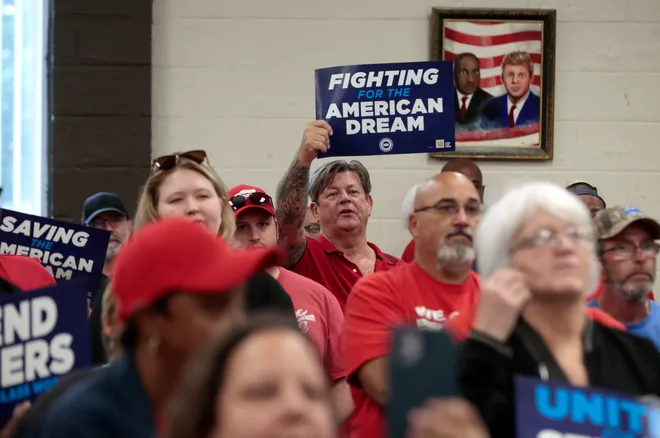As UAW strike deadline nears, these states may experience the most significant job losses
Ten states would take the brunt of any economic hit if the United Auto Workers union becomes embroiled in a lengthy strike against the Big Three automakers -- Ford, General Motors and Stellantis.
Michigan would face deeply troubling job losses across the economy — including more than 300,000 people without a paycheck, according to a new report issued Wednesday by University of Michigan economists. The strike's impact could reach as far as Texas and New York.
The economic risks are huge — and elevated these contract talks by cumbersome issues including the UAW's efforts to establish job security as automakers shift into producing more, but less labor intensive, electronic cars and trucks. Other key issues include the union's demands for much higher wages to combat high inflation, an end to wage systems that pay some workers substantially less, and better retirement benefits for many UAW members who aren't covered by pensions.
The extreme level of job losses in Michigan in a lengthy strike scenario wouldn't be as bad as what the state saw back in early 2020 at the start of the pandemic. But it would be brutal, representing nearly one-third of jobs lost in Michigan during economic shutdowns when the COVID-19 pandemic first hit, according to the report by the University of Michigan Research Seminar in Quantitative Economics.
During a strike, lost wages put families under greater financial stress and contribute to lost tax revenue. Some money can be recovered once a strike is over and workers benefit from wage gains, including any lump-sum payments upfront. Again, though, much will depend on how long a strike might run, which of the automakers are targeted and the agreements that are reached at the end.
Recession?UAW strike could cost US economy billions but will it push the nation into a recession?
While many remember a 40-day UAW strike at General Motors in 2019, strikes in the auto industry haven't been common in recent years. Yet if you go back to the contract years between 1961 and 1976, the report noted, the contract negotiations always included a strike. And the U-M report noted that strikes since 1960 have tended to be "fairly short, lasting a few days to a few weeks."
A 2023 strike by the UAW against the automakers, which seems likely at this point, could be unlike any other in history.
The UAW leadership hints that the union will engage in highly unusual rolling strikes — or strategic strikes — that hit specific operations at all automakers at various times. Such labor disruptions could trigger far more uncertain scenarios. How long such strike actions stretch out before agreements are reached remains mindboggling this early in the game.

The U-M report noted: "The UAW has never led a strike at more than one company during a contract year."
Possible scenarios for job losses as a result of UAW strike
The U-M report offers hypothetical strike scenarios if the UAW doesn't reach agreements with automakers by the 11:59 p.m. deadline Thursday — or relatively soon afterward. The UAW appears unlikely to extend talks beyond the deadline based on earlier comments by its leadership.
Seeing the numbers can be startling — even when many people in Michigan aren't employed directly by automakers or auto suppliers.
Another U-M economic outlook report noted that the Bureau of Labor Statistics reported that 4,764,400 Michiganders were employed as of July.
The U-M report estimates that Michigan has 66,412 total UAW workers at Big Three facilities, the most in the nation, with roughly 25,000 at Stellantis, 22,000 at Ford, and 20,000 UAW-represented workers at GM.
Ohio is next on the list with 16,240 UAW workers at facilities run by the three automakers, it is followed by Kentucky, which has 13,143 UAW-represented workers employed at operations for the three automakers.
These 10 states face the most risk from UAW walkout
The economic hit would be felt most severely in basically 10 states.
Nine have assembly plant runs by the three automakers, according to the report. The states listed in descending order of production are: Michigan, Kentucky, Missouri, Ohio, Texas, Illinois, Indiana, Kansas and Tennessee.
New York does not have any assembly plants, but it is home to a Ford Stamping plant, two GM component plants, and a GM engine plant, together employing nearly 4,300 workers.

The U-M report estimates nearly 140,000 UAW workers at Big Three facilities across the U.S. The figures are based on information for various facilities provided on Ford, GM, and Stellantis corporate websites.
Job losses would be felt throughout the automotive supply chain, particularly if a strike were ongoing.
Would some suppliers hold off on layoffs?
Gabriel M. Ehrlich, director of the U-M Research Seminar in Quantitative Economics in Ann Arbor, noted in the report that based on conversations with industry experts, it's likely that many suppliers to the three automakers, as well as other businesses affected, could try to avoid layoffs for as long as possible. The report assumed no layoffs would take place among auto suppliers for the first two weeks of a potential strike.
The reason? Analysts expect that there could be some “labor hoarding” to reflect a tight labor market when it can be more difficult to hire new skilled workers.
"It is also possible that the target company of a strike would choose to continue paying suppliers to produce even during a strike in order to allow for faster 'catch-up production' after the strike’s conclusion," the report noted.

The 300,000 figure for more sweeping job losses relating to a UAW strike applies — actually adding up to 313,000 total job losses throughout the Michigan economy — if the strike were to last eight weeks and hit all three automakers. It reflects spillovers to automakers and the broader economy.
The U-M report does not explicitly simulate any scenarios involving a strike at more than one of the three automakers simultaneously.
Contact personal finance columnist Susan Tompor: stompor@freepress.com. Follow her on Twitter @tompor.
Disclaimer: The copyright of this article belongs to the original author. Reposting this article is solely for the purpose of information dissemination and does not constitute any investment advice. If there is any infringement, please contact us immediately. We will make corrections or deletions as necessary. Thank you.







